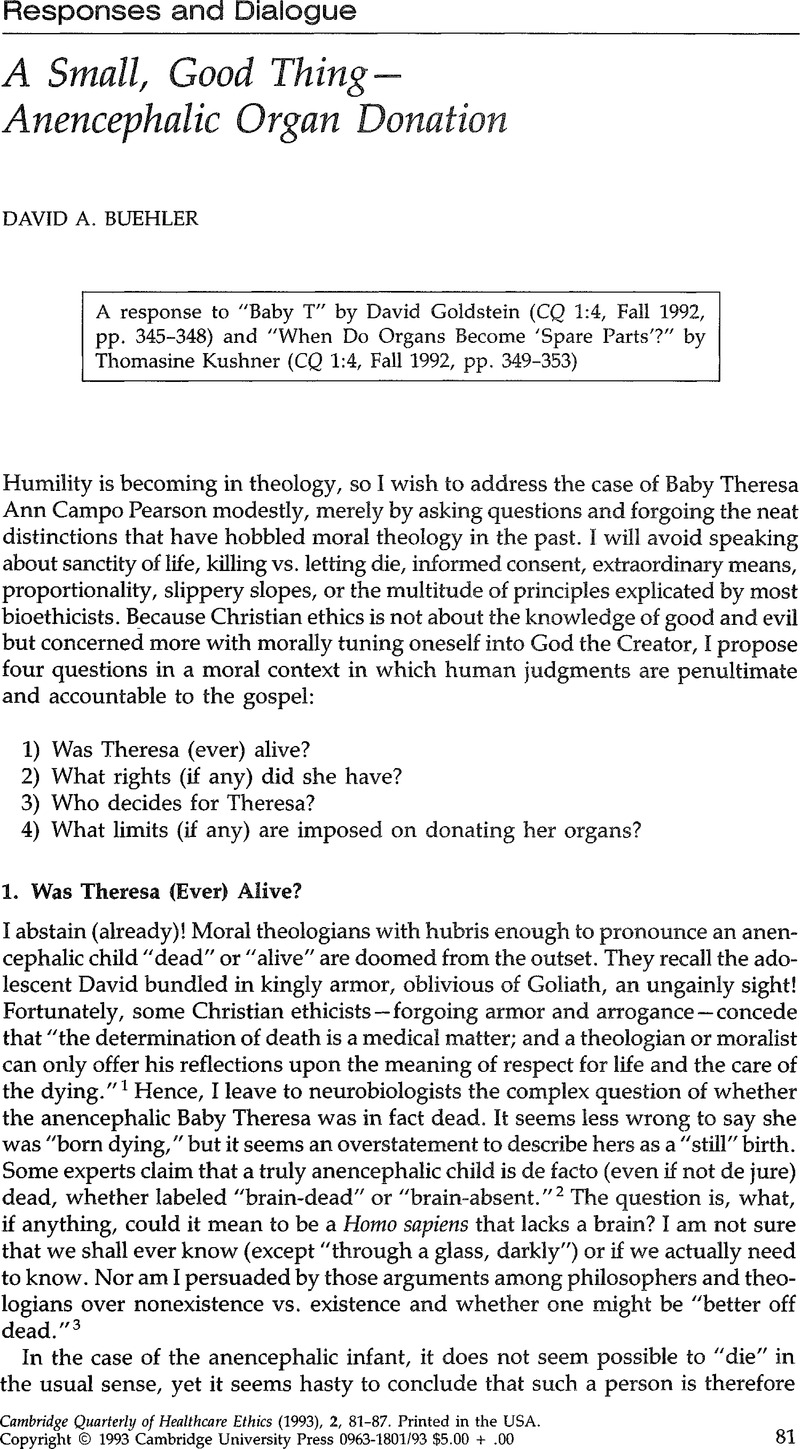No CrossRef data available.
Article contents
A Small, Good Thing – Anencephalic Organ Donation
Published online by Cambridge University Press: 29 July 2009
Abstract

- Type
- Responses and Dialogue
- Information
- Copyright
- Copyright © Cambridge University Press 1993
References
Notes
1. Ramsey, P. Patient as Person. New Haven, Connecticut: Yale University Press, 1970:104.Google Scholar Cf. Hauerwas, S. Suffering Presence. Notre Dame, Indiana: University of Notre Dame Press, 1986:88.Google Scholar
2. M. Harrison has argued compellingly for a classification of “brain-absent” dead people, but this smacks of tautology. “Brain-absent” is no more revealing than the diagnostic term “anencephalic” itself, Harrison, M, Meilaender, G. The anencephalic newborn as organ donor. Hastings Center Report 1986; 16(2):21–3.CrossRefGoogle Scholar
3. Arras, JD. Toward an ethic of ambiguity. Hastings Center Report 1984;14(2):26.Google ScholarPubMedToulmin, S. The Place of Reason in Ethics. Chicago: University of Chicago Press, 1950 (rev. ed. 1986):190f.Google Scholar
4. Ramsey, P. Ethics at the Edges of Life. New Haven, Connecticut: Yale University Press, 1978:213ff.Google Scholar Cf. Weir, R. Selective Nontreatment of Handicapped Newborns. Oxford, England: Oxford University Press, 1984.Google Scholar For an earlier discussion of “selective nontreatment,” cf. Harris, J. Ethical problems in the management of some severely handicapped children. Journal of Medical Ethics 1981;7:117–24.CrossRefGoogle ScholarPubMed
5. Beller, FK, Quackernack, K, Fragen zur Bioethik: Terirtinierung der Schwangerschaft im und III. Trimenon aus eugenischer Indikation. Geburtshilfe und Frauenheilkunde 1980;40:142–4.CrossRefGoogle Scholar Cf. Hozgreve, W, Beller, FK, Buchholz, B. Kidney transplantation from anencephalic donors. New England Journal of Medicine 1987;316(17);1069–70.CrossRefGoogle ScholarChervenak, F, Farley, M et al. , When is termination of pregnancy during the third trimester morally justifiable? New England Journal of Medicine 1984;310(8):501–4.CrossRefGoogle ScholarPubMedHaering, B. Medical Ethics. Notre Dame, Indiana: Fides, 1973:109–11.Google Scholar
6. Stone, C. Should Trees Have Standing? Los Altos, California: W. Kaufmann, 1972.Google ScholarCf. Singer, P. In Defense of Animals. New York: Harper … Row, 1985.Google ScholarLindzey, A. Christianity … the Rights of Animals. New York: Crossroad, 1987.Google ScholarRegan, T. The Case for Animal Rights. Berkeley: University of California Press, 1983.Google Scholar
7. See note 3. Arras, . 1984;14(2):25.Google ScholarHolbrook, D. Medical ethics and the potentialities of the living being. British Medical Journal 1985;291:459–62.Google ScholarPolanyi, M. Chemical and Engineering News 1967;45:54–66.CrossRefGoogle ScholarJonas, H. The Phenomenon of Life. New York: Delta, 1966:7–37.Google Scholar See note 1. Ramsey, . 1970:24.Google Scholar On artificial intelligence: Penrose, R. The Emperor's New Mind. New York: Oxford University Press, 1989:425–34.Google ScholarWarnock, M. Memory. London: Faber & Faber, 1987: 8–9Google Scholar
8. Singer, P. Practical Ethics. Cambridge, England: Cambridge University Press, 1979.Google ScholarFletcher, JF. Four indicators of humanhood- the enquiry matures. Hastings Center Report 1974; 4(6):4–7.CrossRefGoogle ScholarPubMed
9. Brock, D, Buchanan, A. Deciding for Others: The Ethics of Surrogate Decision Making. Cambridge, England: Cambridge University Press, 1989.Google ScholarSinger, MG. The golden rule. Philosophy 1963;38 (10.):293–314.CrossRefGoogle Scholar
10. Gaylin, W. Harvesting the dead. Harper's 1974 Sep. 1974;249(1492):23–30.Google ScholarKushner, T, Belliotti, R. Baby Fae: a beastly business. Journal of Medical Ethics 1985;11:178–83.CrossRefGoogle ScholarPubMed
11. May, W. The metaphysical plight of the family. In: P, Steinfels, RM, Veatch, eds. Death Inside Out. New York: Harper Forum, 1974:49–60.Google ScholarShelp, E. Born to Die? Deciding the Fate of Critically III Newborns. New York: Free Press, 1986:197–201.Google Scholar
12. JR, Nelson. Ten theses concerning human beings. In: S, Lammers, A, Verhey, eds. On Moral Medicine: Theological Perspectives in Medical Ethics. Grand Rapids, Michigan: Eerdmans, 1987:615–6.Google Scholar Cf. Nozick, R. The Examined Life. New York: Simon 46–54.Google Scholar




